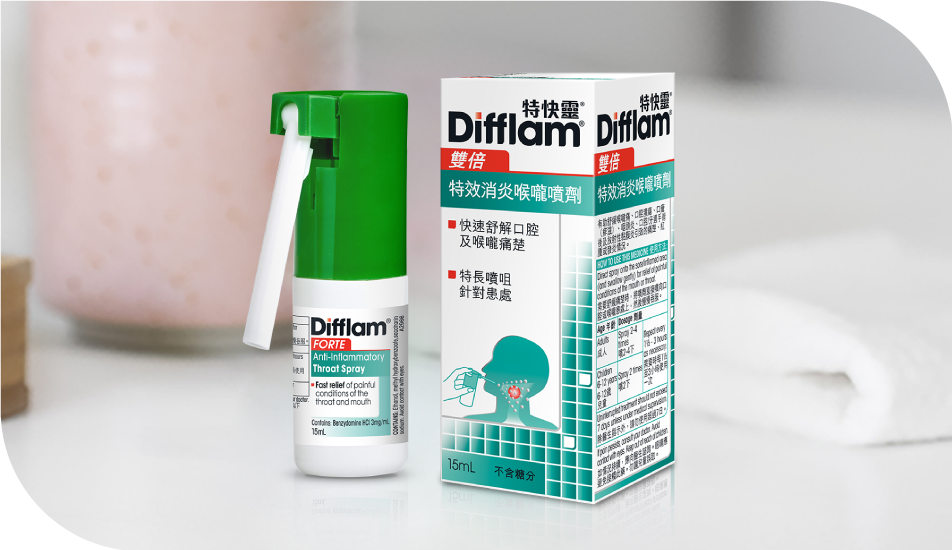
Managing a Painful Sore Throat or Mouth Condition
A sharp, stabbing sore throat can be distressing – find out how you can find relief.
Painful sore throats and mouth conditions such as mouth ulcers can be downright tough, but let’s help you understand a bit more about what causes the pain and steps you can take to find the right relief for your symptoms.
Painful, swollen sore throat
A sore throat is essentially the tissues in the back of your mouth and throat becoming inflamed – usually in response to an infection. When you have a sore throat that is particularly painful, you might describe the feeling as prickly, sharp, stabbing pains like there are razor blades or knives in your throat. And while most sore throats go away by themselves after about seven days, there’s really no need to suffer with your throat pain – there are different ways you can manage the pain.
Sharp stabbing sore throat
An acute painful sore throat can be distressing, but you are not alone. An online survey of over 5000 people from several countries found that moderate-to-severe pain occurs in roughly 70% of people with a sore throat, and that sore throats occur around four times a year.
When it comes to the main symptoms of an acute painful sore throat, a study of 369 adults with an acute sore throat (so less than three days) found that 30% of people experience swollen, inflamed throats with difficulty swallowing.
The most common cause of a sore throat is an infection that is caused by a virus or bacteria. Other things that can cause a painful sore throat include smoking, air pollution, hot and dry air, snoring or shouting. All of these things trigger inflammation, which is a key cause of the pain of a sore throat.
Painful mouth conditions
Other painful mouth conditions include things such as mouth ulcers. These are small, painful areas that form inside your lips, inside your cheeks, or on the bottom of your mouth when the tissues are damaged. This damage usually happens because of an injury – for example, accidentally biting the inside of your lip with sharp teeth or rubbing from dentures or braces. Like a sore throat, mouth ulcers usually go away on their own in about 10 to 14 days, but there are some things you can do to help relieve the pain while you wait.
- Avoid touching the sore areas in your mouth
- Avoid hot or spicy food and drinks
- Drink lots of fluids
Rinse your mouth with DIFFLAM C-Solution or DIFFLAM Solution for targeted relief from pain and inflammation, local relief from oral lesions, and a soothing and refreshing sensation through your whole mouth.

Treatments and what can make me feel better
It can be difficult understanding some of the different claims on different products. When it comes to sore throats, there are some key ingredients to look out for: antibacterial, anti-inflammatory, anaesthetic, and analgesic agents.
An antibacterial helps to fight infections that can cause inflammation – a key cause of painful sore throats and mouth conditions.
An anti-inflammatory prevents or reduces inflammation. As mentioned above, the inflammatory response to an infection is the most likely cause of the pain and discomfort you feel with a sore throat.
An anaesthetic (spelled anesthetic in the USA) is an agent that causes a loss of sensation, awareness, or numbness. They can either apply to the whole body, rendering you unconscious (a general anaesthetic) or only to a specific section (a local anaesthetic). For sore throat relief, we are talking about a local anaesthetic.
An analgesic is the name given to active ingredients that help relieve pain. It differs from an anaesthetic by working to relieve pain, rather than causing a numbing sensation.
The AAA difference with DIFFLAM
A key ingredient in the DIFFLAM Anti-inflammatory range is the unique non-steroidal anti-inflammatory benzydamine which offers Triple A expert care – acting as an anti-inflammatory, analgesic, and anaesthetic all at once. The three As are:
Anti-inflammatory – benzydamine strongly inhibits the inflammation pathways to relieve pain and swelling
Analgesic – benzydamine accumulates in the inflamed areas of the mouth and throat
Anaesthetic (local) – benzydamine acts rapidly with the numbing effect lasting for up to 90 minutes
- Eccles R. Mechanisms of symptoms of common cold and flu. In: Common Cold. Eccles R, Weber O (Eds); Birkhauser Verlag 2009; Basel, Switzerland.
- Worrall G. Acute sore throat. Can Fam Phys. July 2011;57:791-794.
- Kenealy T. Sore throat. BMJ Clin Evid. 2014;2014:1509
- Shephard A. J Family Med Community Health. 2014;1(3): 1014.
- Schachtel B, et al. J Pain. 2012;13(4) S6. doi: 10.1016/j.jpain.2012.01.031.
- Addey D, Shephard A. BMC Ear, Nose and Throat Disorders. 2012;12:9.
- Renner B, Mueller CA and Shephard A, Inflamm Res. 2012; 61(10)- 1041–1052.
- Better Health Channel. Mouth Ulcers [April 2021]. Available: https://www.betterhealth.vic.gov.au/health/conditionsandtreatments/mouth-ulcers (accessed April 2022)
- HealthDirect. Mouth sores and ulcers [December 2019]. Available: https://www.healthdirect.gov.au/mouth-sores-and-ulcers (accessed April 2022)
- The Free Dictionary. Search terms ‘antibacterial’, ‘anaesthetic’, ‘anti-inflammatory’ and ‘analgesic’. Farlex; 2003–2021. Available from: https://medical-dictionary.thefreedictionary.com/.
- Eccles R. Understanding the symptoms of the common cold and influenza. Lancet Infect Dis. Nov 2005;5:718-725.
- Drugbank. Benzydamine Product Overview. [Internet] [cited 2020 Mar 27] Available from: https://www.drugbank.ca/drugs/DB09084 (accessed April 2022).
- Turnbull RS. Benzydamine hydrochloride (Tantum) in the management of oral inflammatory conditions. Pharmacology.1995;61(2):127-34.
- Simard-Savoie S, Forest D. Topical anaesthetic activity of benzydamine. Curr Ther Res. 1978;6:734-5.
